The answer to this question is probably more than obvious, but I just cannot get my head around (or rather, I think I know a solution, but it appears to complicated to me), so I thought I should ask for help.
My data looks like this:
MyItem Measurement First Last
Item1 10 267.4 263.2
Item2 15 263.2 254.8
Item3 3 250.5 250.5
Item4 20 266.9 253.2
Item5 16 260.0 250.0
My measurement for the first item is valid for the time 267.5 to 263.2 (arbitrary time units; could be seconds, years, ...). The measurement for the second item is valid from 263.2 to 254.8 and so on.
I would like to create a plot in R, where the x-axis represents time and the y-axis represents our measurements. Time should be divided in intervals of length 1. If the interval of our measurements overlaps with the time interval of the x-axis, a data point should appear in our plot (in the middle of the time interval on the x-axis). To give an example: Let's assume that our x-axis starts at 269 and ends at 249. Our first time interval on the x-axis goes from 269 to 268. None of our measurements falls into this time interval, therefore no data point is plotted. Our second time interval on the x-axis goes from 268 to 267. A measurement for Item1 has been recorded for this time interval. Therefore a data point is plotted in our time interval 268-267, with y=10 (our measurement) and x=267.5 (midpoint of our time interval 268-267). Our third time interval goes from 267 to 266. Two of our measurements fall into this time interval, namely Item1 and Item4. Therefore, two data points should be plotted, with the coordinates y=10, x=266.5 (Item1) and y=20, x=266.5 (Item4). We proceed like this for the rest of our data.
Unfortunately I haven't found a smart function/package to do this in R - usually you can only supply one value for the y-axis (which makes sense, as otherwise the mapping of your x-value becomes ambiguous) - but I'm sure there must be something. I thought that by using seq() I could create dummy values for every single time step (e.g., dummy values for Item1 would be 267.5, 266.5, 265.5, 264.5, 263.5 - all of them associated with y=10) and add those values to my data. But this appears to me as a very complicated solution, far from being elegant.
I'm sure there must be an easy and elegant way of doing this, but I can't come up with it. I don't even know, what I should look for - I thought you would see this issue come up in time series analyses, but that does not appear to be the case. What I do NOT want to do, is to take the mean time between the begin and the end of the time interval (e.g., for Item1 267.5+263.2/2 = 265.35).
If possible I would like to plot the scatter plot with ggplot2 (but I take any solution) and then fit a line through my plotted data points.
Thanks in advance for any help!
